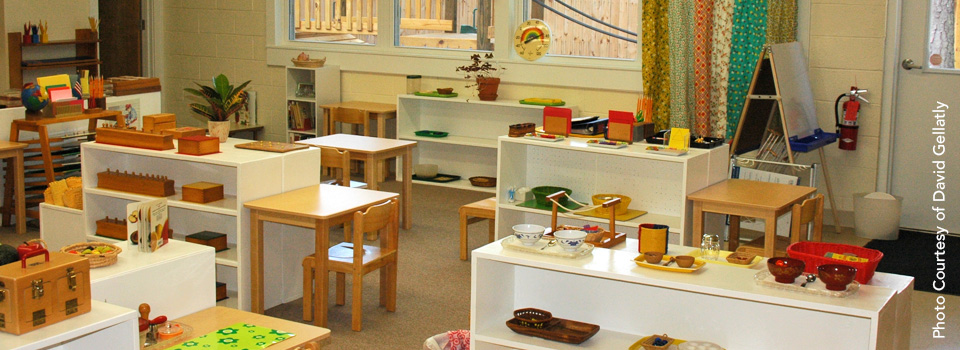Schedule
8:30-11:45am
Curriculum
The goal of the Montessori Day School preschool class is to help each child develop within himself or herself the foundational habits, attitudes, skills, appreciations and ideas which are essential for a lifetime of creative learning. The programmed activities involve handling, manipulating and working with materials designed around these goals and prove to be intensely fascinating and effective for the young child…
“One must learn by doing the thing, for though you think you know it, you have no certainty until you try.”-Maria Montessori
Classroom activities are prepared in the areas of Practical Life, Sensorial, Cultural, Mathematics, Language, and Art/Music/Movement.
Practical Life
The practical life area encourages children to refine their fine and gross motor skills while developing concentration, good work habits and sense of order. Children working in this area gain independence for all areas of the classroom and at home. The practical life area is divided into these main areas of development:
- Care of Person: Dresses self, cares for belongings, washes hands
- Care of Environment: Sweeping, polishing, washing, cleaning up a spill
- Grace and Courtesy: Greets and shakes hands, interrupts properly, respects workspace and concentration of others, cares for materials and classroom
- Control and Coordination of Movement: Carrying trays, using a pencil, using scissors, stopping when the bell rings, standing in line, sitting at group time
Sensorial
The sensorial area helps the child explore the world through the five senses. Sensorial materials isolate a single quality, such as color, weight, shape, texture, size, sound, smell, etc. and emphasize this one particular quality by eliminating or minimizing other differences. This allows children to experience relationships and sequences in order to distinguish, categorize, and relate new information to what they already know.
- Visual: Brown stairs, pink tower, knobbed cylinders, knobless cylinders, color tablets
- Tactile: Mystery bag
- Sound: Sound cylinders, bell
- Smell: Smelling bottles, seasonal smells (coffee grinding, nutmeg grinding, pumpkin pie)
- Taste: Fruit and vegetable tasting
Cultural
The cultural area of the classroom is divided into: Geography, zoology, botany and physical and earth sciences. Exploration in this area allows the child to define his/her place in the world in relation to themselves and to others as well as learn about different areas of science.
- Geography: Maps, landforms, flags, calendars, peace education
- Physical Science: Magnetic and non-magnetic, sink and float, color mixing
- Earth Science: Weather, seasons, land, air and water
- Zoology: Animal care, living and non-living, 5 classifications of animals
- Botany: Study of plants, leaves, and flowers
Mathematics
The materials in the math area provide concrete experiences in: Counting, recognition of numbers, ordering numerals and counting quantities, the decimal system, and the four operations of addition, subtraction, multiplication and division. Use of these concrete materials leads to better understanding of mathematical concepts and later to abstraction.
- 1-10 Materials: Counting, recognition of numbers, counting quantities
- Linear Counting: 100 boards, short and long chains
- Decimal System: Units, tens, hundreds, thousands
- Operations: Addition, subtraction, multiplication and division
Language
The language area focuses on: Vocabulary enrichment, listening skills, oral expression through conversation and sound games. Individual presentations of the language materials help the child connect phonetic sounds with their letter symbols leading to the blending of sounds that results in reading.
- Oral expression: Songs, conversations, rhymes
- Listening skills: Stories, poems
- Vocabulary Development
- Sound Games
- Sandpaper Letters
- Reading activities
- Pre-writing and writing exercises
Art/Music/Movement
Children can choose from a frequently changing array of materials on the art shelf. They enjoy music and movement daily, as well as music instruction with an experienced music teacher once a week.
- Visual Art: Collage, painting, tracing, drawing, play dough, cutting with scissors
- Music: Songs, bells for transitions
- Movement: Rolling rugs, carrying trays, pushing in chairs, instructional songs, physical education
Please email admin@mdsch.org to schedule a school visit. An interview of a prospective student can be scheduled once MDS has received an application.

